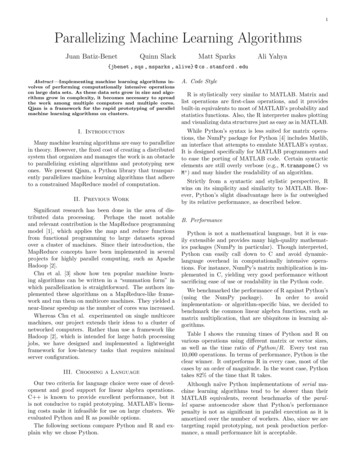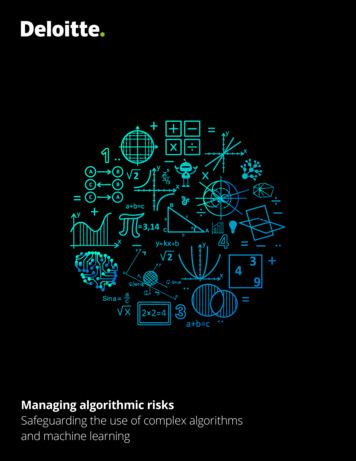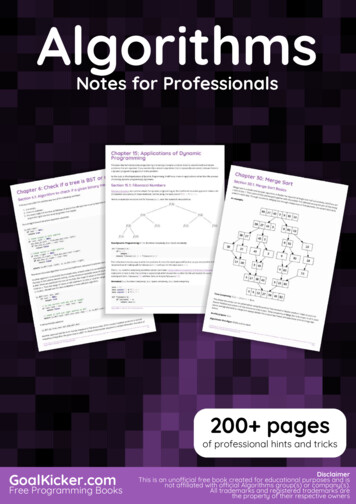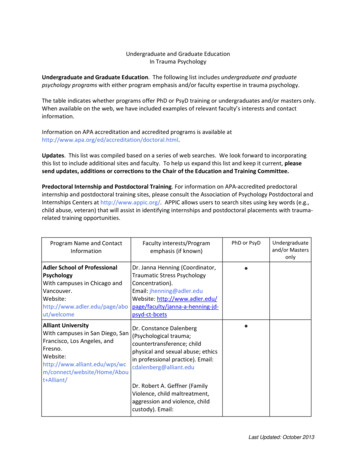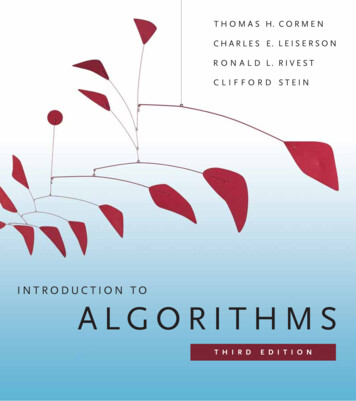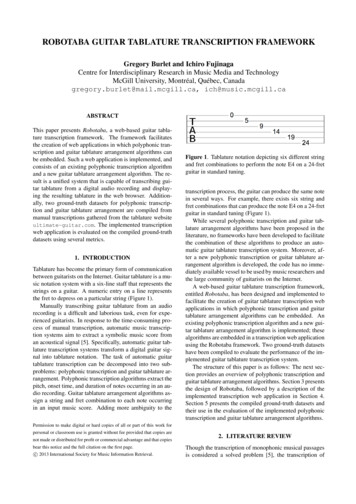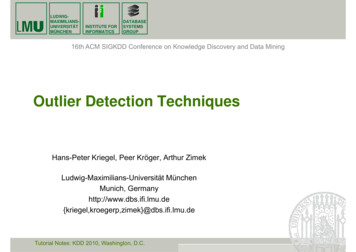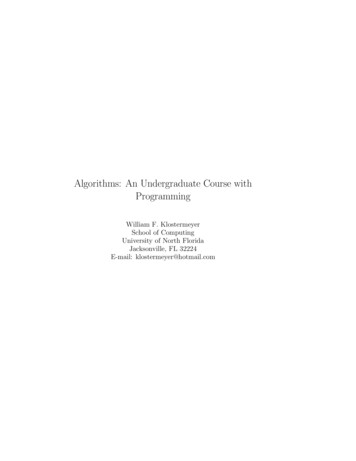
Transcription
Algorithms: An Undergraduate Course withProgrammingWilliam F. KlostermeyerSchool of ComputingUniversity of North FloridaJacksonville, FL 32224E-mail: klostermeyer@hotmail.com
2
Contents0 Preface0.1 Course Outlines . . . . . . . . . . . . . . . . . . . . . . . . . .0.2 Java Notes . . . . . . . . . . . . . . . . . . . . . . . . . . . .78111 Introduction131.1 Exercises . . . . . . . . . . . . . . . . . . . . . . . . . . . . . 191.2 Programming Assignments . . . . . . . . . . . . . . . . . . . 191.3 Chapter Notes . . . . . . . . . . . . . . . . . . . . . . . . . . 192 Algorithmic Thinking2.1 Programming Assignments. . . . . . . . . . . . . . . . . . .3 Growth of Functions3.1 Big Oh et al. . . . . . . . . . .3.2 Some Example Code Segments3.3 Recursive Algorithms . . . . . .3.3.1 Recurrence relations . .3.3.2 Master Theorem . . . .3.4 Exercises . . . . . . . . . . . .3.5 Programming Assignments . .2127.29313942475154594 Sorting, Selection, and Array Problems4.1 Searching . . . . . . . . . . . . . . . . .4.2 Sorting . . . . . . . . . . . . . . . . . . .4.2.1 QuickSort . . . . . . . . . . . . .4.2.2 Heaps and Priority Queues . . .4.2.3 HeapSort . . . . . . . . . . . . .4.2.4 Linear Time Sorting . . . . . . .4.3 Finding the Median . . . . . . . . . . .4.4 More Array Problems . . . . . . . . . .6161646468727577793.
4CONTENTS4.54.64.74.8String Matching . . . . . . . . . . . . .Another Recursive Algorithm . . . . . .4.6.1 Naive Matrix Multiplication . . .4.6.2 Recursive Matrix MultiplicationExercises . . . . . . . . . . . . . . . . .Programming Assignments . . . . . . .5 Graph Algorithms and Problems5.1 Storage . . . . . . . . . . . . . . . .5.2 Algorithmic Techniques . . . . . . .5.2.1 Greedy Algorithms . . . . . .5.2.2 Brute-Force . . . . . . . . . .5.3 Path Problems . . . . . . . . . . . .5.3.1 Breadth-First Search . . . . .5.3.2 Dijkstra’s Algorithm . . . . .5.3.3 Consistent Paths . . . . . . .5.3.4 All-Pairs Shortest Path . . .5.3.5 Maximum Flow . . . . . . . .5.4 Stable Marriage Problem . . . . . .5.5 Spanning Trees . . . . . . . . . . . .5.5.1 Union-Find Data Structures .5.5.2 Prim’s Algorithm . . . . . . .5.5.3 Kruskal’s Algorithm . . . . .5.5.4 MST with 0-1 Edge Weights5.6 Exercises . . . . . . . . . . . . . . .5.7 Programming Assignments . . . . .6 Advanced Algorithms and Problems6.1 Depth-first Search . . . . . . . . . .6.2 Strongly Connected Components . .6.3 Graph Coloring . . . . . . . . . . . .6.3.1 Basics . . . . . . . . . . . . .6.3.2 Planar Graph Coloring . . . .6.4 Analysis of a Greedy Dominating Set6.4.1 Introduction . . . . . . . . .6.4.2 The Heuristic . . . . . . . . .6.4.3 The Naive Implementation .6.4.4 Choosing a Data Structure .6.4.5 Combining Two Algorithms .6.4.6 Combinatorial Tricks . . . . . . . . . . . . . . . . . . . . . . . . . . . . . . . . . . .Algorithm. . . . . . . . . . . . . . . . . . . . . . . . . . . . . . . . . . . . 07108109110.111. 111. 113. 118. 118. 118. 120. 120. 124. 124. 125. 126. 127
CONTENTS6.56.66.76.856.4.7 Elegant Data Structure . . . . . . . . . . . . . . . . . 129More Dynamic Programming Examples . . . . . . . . . . . . 1316.5.1 Matrix Chain Multiplication . . . . . . . . . . . . . . 1316.5.2 DNA Sequence Alignment . . . . . . . . . . . . . . . . 1336.5.3 A Decision Problem example of Dynamic Programming1366.5.4 Knapsack . . . . . . . . . . . . . . . . . . . . . . . . . 1386.5.5 Offline 2-server algorithm . . . . . . . . . . . . . . . . 1406.5.6 Trees . . . . . . . . . . . . . . . . . . . . . . . . . . . . 142Linear Algebra Tools – An Overview . . . . . . . . . . . . . . 1426.6.1 Solving Sets of Linear Equations . . . . . . . . . . . . 1426.6.2 More on Matrices . . . . . . . . . . . . . . . . . . . . . 1426.6.3 Linear Programming . . . . . . . . . . . . . . . . . . . 1426.6.4 Integer Linear Programs . . . . . . . . . . . . . . . . . 142Exercises . . . . . . . . . . . . . . . . . . . . . . . . . . . . . 142Programming Assignments . . . . . . . . . . . . . . . . . . . 1447 Complexity: An Introduction1457.1 Introduction . . . . . . . . . . . . . . . . . . . . . . . . . . . . 1457.1.1 Easy Problems, Efficient Algorithms . . . . . . . . . . 1457.1.2 Problems, Instances and Solutions . . . . . . . . . . . 1477.2 The Failure of Greedy Algorithms . . . . . . . . . . . . . . . 1507.3 A Classification of Problems . . . . . . . . . . . . . . . . . . . 1507.4 NP-completeness and Complexity Classes . . . . . . . . . . . 1537.4.1 Reductions . . . . . . . . . . . . . . . . . . . . . . . . 1537.4.2 Formal Definition of NP-Completeness and Examplesof NP-Complete Problems . . . . . . . . . . . . . . . . 1567.4.3 Some More NP-complete Problems . . . . . . . . . . . 1577.4.4 Remarks on Relationship Between Problem Classes . . 1597.4.5 3-SAT is N P -complete . . . . . . . . . . . . . . . . . . 1607.4.6 Proving NP-completeness by Restriction . . . . . . . . 1647.4.7 Some Reductions . . . . . . . . . . . . . . . . . . . . . 1667.5 Approximation Algorithms . . . . . . . . . . . . . . . . . . . 1737.5.1 Definitions . . . . . . . . . . . . . . . . . . . . . . . . 1737.5.2 Vertex Cover . . . . . . . . . . . . . . . . . . . . . . . 1767.5.3 Traveling Salesman’s Problem . . . . . . . . . . . . . . 1807.5.4 Multi-processor Scheduling . . . . . . . . . . . . . . . 1837.5.5 Bin-Packing . . . . . . . . . . . . . . . . . . . . . . . . 1857.5.6 Max-SAT and Max-Cut: Randomized Algorithms . . . 1867.5.7 Approximation Schemes . . . . . . . . . . . . . . . . . 1867.5.8 Impossibility of Approximation . . . . . . . . . . . . . 186
6CONTENTS7.67.7Exercises . . . . . . . . . . . . . . . . . . . . . . . . . . . . . 189Programming Assignments . . . . . . . . . . . . . . . . . . . 1898 On-line Algorithms8.1 Simple Amortization Arguments . . . . . .8.2 On-line Algorithms . . . . . . . . . . . . . .8.2.1 Move-to-front List . . . . . . . . . .8.2.2 Splay Trees . . . . . . . . . . . . . .8.2.3 Paging and the k-Server Problem . .8.2.4 Examples of More On-line Problems8.3 Dynamic Algorithms . . . . . . . . . . . . .8.3.1 Minimum Spanning Tree . . . . . . .8.3.2 Connected Components . . . . . . .8.4 Exercises . . . . . . . . . . . . . . . . . . .8.5 Programming Assignments . . . . . . . . .1911911911931971972042042042042042049 Mathematical Preliminaries9.1 Functions . . . . . . . . . .9.1.1 Basic definitions . .9.1.2 Special Functions . .9.2 Series and Sums . . . . . .9.3 Induction and Proofs . . . .9.4 Graphs . . . . . . . . . . . .9.5 Exercises . . . . . . . . . .9.6 Programming Assignments.205205205205207211214215215.10 Data structures21710.1 Lists . . . . . . . . . . . . . . . . . . . . . . . . . . . . . . . . 21710.2 Trees and Heaps . . . . . . . . . . . . . . . . . . . . . . . . . 21710.3 Programming Assignments . . . . . . . . . . . . . . . . . . . 217
Chapter 0PrefaceThese notes are designed to be accessible: for students to read with the goalof teaching them to understand and solve algorithmic problems. Numerousprogramming assignments are given so that students can see the impact ofalgorithm design, choice of data structure, etc. on the actual running timeof real programs.Emphasis is given to both the design and analysis of algorithms andalthough a few proofs of correctness and other mathematical proofs are givenand assigned that is not the primary emphasis of this text. Implementationdetails are also considered an important part of the learning experience and,accordingly, programming assignments are numerous and compilable Javacode is used for all code in the book: most of these programs have exercisesassociated with them to encourage the students to run them on interestinginputs. Students are expected to have had one semester courses in calculus,data structures, and ideally, discrete mathematics, though a tour of theMathematical Preliminaries chapter should provide a sufficient backgroundfor those who have not had a discrete math course. Likewise, those studentswho have not had a full semester of data structures, could spend a few weekson the data structures chapter before proceeding with the rest of the text(such might be the model for a course that many schools offer called “DataStructures and Algorithms.”)It is not my goal in these notes to avoid mathematical rigor, rather,I have found that a course in algorithms is challenging for most students,as they have not yet developed a lot of experience in algorithmic problemsolving. Thus I believe development of these skills is essential for manystudents, before they can be exposed to a hard-core course in algorithmics.Most of the “Algorithms” books that I have read are either aimed at the7
8CHAPTER 0. PREFACEresearcher/practitioner (such as the wonderful book by Skiena [32]) or aretoo intimidating, terse, thick, or advanced for the “average” undergraduatestudent. These notes were specifically designed to help the student learn tounderstand the basic, fundamental concepts, without overwhelming them. Ihope the exercises, programming assignments and the exposition meet thisobjective. I have evolved this material through numerous adventures in theundergraduate algorithms course at West Virginia University and the University of North Florida and have also used parts of this text (e.g., sometopics from the Advanced Algorithms chapter and some from the Complexity Theory chapter) in graduate courses. But all the material, includingthe exercises, is designed to be highly accessible to undergraduates, eventhose algorithms that I refer to as “advanced.” However, some material hasbeen included for completeness sake that may not need to be covered in afirst course in algorithms – the chapter on N P -completeness, for example (Itypically spend only one or two days on this in a first undergraduate algorithms course) as well as the linear algebra material (again, I may spend oneday at most on this). But I do think these important topics warrant somediscussion and may be included for more advanced students or in a secondsemester undergraduate algorithms course.0.1Course OutlinesThe course outline I have used for a one-semester undergraduate course isas follows:1-2 Introduction and Algorithmic Thinking 1 week9 Mathematical Preliminaries 2 weeks9.1 Series and Sums9.2 Graphs9.3 Induction3 Growth of Functions 2 weeks3.1 Big Oh et al.3.2 Some Example Code Segments3.3 Recursive Algorithms3.3.1 Recurrence relations3.3.2 Master Theorem
0.1. COURSE OUTLINES94 Sorting, Selection, and Array Problems 2 weeks4.1 Searching4.2 Sorting4.2.2 HeapSort4.2.3 Linear Time Sorting4.3 Finding the Median4.6 Another Recursive Algorithm4.6.1 Naive Matrix Multiplication4.6.2 Recursive Matrix Multiplication5 Graph Algorithms and Problems 4 weeks5.1 Storage5.2 Algorithmic Techniques5.2.1 Greedy Algorithms5.2.2 Brute-Force5.3 Path Problems5.3.1 Breadth-First Search5.3.2 Dijkstra’s Algorithm5.3.4 All-Pairs Shortest Path5.3.5 Maximum Flow5.4 Spanning Trees5.4.1 Union-Find Data Structures5.4.2 Prim’s Algorithm5.4.3 Kruskal’s Algorithm5.4.4 MST with 0-1 Edge Weights6.6 Linear Algebra Tools – An Overview 0.5 weeks6.6.1 Solving Sets of Linear Equations6.6.3 Linear Programming7 Complexity – An Introduction 1 weekI then generally to spend the remaining two to three weeks on selectedtopics.A lower-level (sophomore?) course called “Data Structures and Algorithms” might use an outline such as the following:1 Introduction 0.5 weeks
10CHAPTER 0. PREFACE9 Mathematical Preliminaries 2.5 weeks9.1 Series and Sums9.2 Graphs9.3 Induction10 Data Structures 3 weeks10.1 Lists10.1.1 Linked Lists, Doubly-Linked Lists, Queues, Stacks10.1.2 Move-to-Front-Lists10.2 Trees10.2.1 Binary Trees10.2.2 Heaps10.2.2.1 Heaps as Trees10.2.2.2 Heaps as Arrays10.2.2.3 How many arrays are heaps?10.2.3 Balanced Trees10.2.4 B-trees 10.2.5 Splay Trees2 Algorithmic Thinking 2 weeks3 Growth of Functions 2 weeks3.1 Big Oh et al.3.2 Some Example Code Segments3.3 Recursive Algorithms3.3.1 Recurrence relations3.3.2 Master Theorem4 Sorting, Selection, and Array Problems 2 weeks4.1 Searching4.2 Sorting4.2.2 HeapSort4.2.3 Linear Time Sorting4.3 Finding the Median4.6 Another Recursive Algorithm4.6.1 Naive Matrix Multiplication4.6.2 Recursive Matrix Multiplication5 Graph Algorithms and Problems 2 weeks5.1 Storage5.2 Algorithmic Techniques5.2.1 Greedy Algorithms
0.2. JAVA NOTES115.2.2 Brute-Force5.3 Path Problems5.3.2 Dijkstra’s Algorithm5.3.4 All-Pairs Shortest Path5.3.5 Maximum Flow5.4 Spanning Trees5.4.2 Prim’s Algorithm5.4.4 MST with 0-1 Edge Weights7 Complexity – An Introduction 1 week0.2Java NotesAll pseudocode programs in this text have Java counterparts on my website. All programs in this text were compiled with JDK 1.2, available fromwww.sun.com (Sun Microsystems). I have attempted to make the codeas clear as possible, and thus it may not be as “object-oriented” as somemay like. I have annotated code with “ ” symbols to indicate where onemight place statements such as “counter ;” as suggested in the exercisesfollowing the programs. That is, some exercises ask the student to embeda counter inside a program and print the value of the counter at the end ofthe program to observe the number of iterations. Again for clarity, I do notinclude the statements related to the counter in the code, but do indicatewhere these statements should be placed.Most input/output is done with the following methods, which are notincluded in the code in the text, for sake of brevity and clarity, but will needto be included with any programs that use them. The methods are takenfrom the text ”Data Structures and Algorithms in Java” by Robert Lafore.At the beginning of the program file we use:import java.io.*;import java.lang.Integer;// for I/O// for parseInt()At the end of the “main” class, we place the -----------------------public static void putText(String s){System.out.print(s);
12CHAPTER 0. ----------------------------------------public static String getString() throws IOException{InputStreamReader isr new InputStreamReader(System.in);BufferedReader br new BufferedReader(isr);String s br.readLine();return ---------------public static char getChar() throws IOException{String s getString();return -------------------------public static int getInt() throws IOException{String s getString();return Integer.parseInt(s);}
Chapter 1IntroductionAnyone who has ever written a program is hopefully aware of the time required for the program to execute. Some programs may run so fast youdon’t notice, while others may run for seconds or minutes or even more.As an example, try implementing the following (in your favorite language),which inputs an integer and determines whether or not it is prime (recallthat an integer n is prime if it is evenly divisible only by 1 and n, so forexample, 12 is not prime since 12 2 2 3, and 17 is prime. In other words,17 mod i 0 for all i such that 2 i 16):import java.io.*;class TrialDivision{public static void main(String[] args){int n;boolean prime;n getInt();// test if n is primeprime true;for (i 2; i n; i ) {if (n % i 0) prime false;}13// for I/O
14CHAPTER 1. INTRODUCTIONif (prime) putText("Prime") else putText("Composite’);}}Exercise Run this program for a large value of n, say, 32,567. How longdid it take? What about for n 1, 000, 003? How long did it take?The clever reader will realize that we can improve the program as follows, since if n has a non-trivial divisor, it must have one whose value is at most n:n : long integer;prime : boolean;input(n);-- test if n is prime -prime: true;for i in 2.sqrt(n)if n mod i 0 thenprime: false;end;if prime then print("Prime") else print("Composite’);Exercise How long did this program take for n 32, 567, for n 1, 000, 003? How long does it take for n 232 1?Exercise Write a program to implement the sieve of Eratosthenes (datesfrom around 200 B.C.) to test if an integer x is prime: in the range from 2to x, mark all numbers divisible by 2 that are greater than 2, (so you wouldmark 4, 6, 8, 10, . in increasing order); then mark all numbers divisibleby 3 that are greater than 3. Each subsequent iteration, mark all numbers divisible by smallest unmarked number that has not been used before.Numbers left unmarked at the end are prime. Compare the running time ofthis on large integers with the previous approaches.
15Now we have seen several programs to solve the same problem (testingfor primality), where one runs quite slowly and another runs more quickly(though, as you should observe, still fairly slow for super large values ofn). 1 . The fact that factoring very large integers is computationally timeconsuming is the basis for many encryption schemes such as the RSA algorithm [11]!Algorithmic problems come in many varieties: numerical problems suchas primality testing or finding the roots of a polynomial, matrix problems,algebraic problems, logic problems (is a given Boolean formula a tautology),graph problems (find the largest independent set in a graph), text problems(find the first occurrence of some pattern in a large text), game problems(is a given chess position winning for white), and many others. But foreach problem, we shall be concerned with whether it is solvable, whether itis efficiently solvable, and how to design and analyze algorithms for theseproblems.Every year it seems, faster (and cheaper) computers become availableand the computer companies entice buyers with how fast their programs willrun. However, equally important as the speed of the computer or processoris the speed of the program (or algorithm) itself. That is, a computer thatis twice as fast as an old computer can only speed up our programs by afactor of two; whereas a faster algorithm might speed up a program by ahundred-fold. Compare the above two programs: run the slower one on afast computer and the faster one on a slow computer for some large inputs.What can you conclude?Our goal in this text is to understand how the choice of algorithm (ordata structure) affects the speed with which a program runs and be able toeffectively solve problems by providing efficient algorithmic solutions, if anefficient solution is in fact possible.The ACM (Association for Computing Machinery, the main professionalorganization for computing professionals) published a definition of computerscience that begins“Computer science . . . is the systematic study of algorithmic processes.”(from “Computing as a Discipline” by the ACM Task Force on the Core ofComputing, Communications of the Association for Computing Machinery,vol. 32, 1989).We may define an “algorithm” as a finite sequence of steps (instructions)1Faster, though more complex, algorithms for primality testing exist [28, 25, 1, 2]
16CHAPTER 1. INTRODUCTIONto solve a problem. A computer program is, in purest form, just a realizationof an algorithm.There are three sides to the study of algorithms:(1) Analysis: given a program (or an algorithm), how fast does it run(or how much space does it use) and how can we improve or optimize itsperformance.(2) Design: given a problem, how can we solve it efficiently (if in fact, itis solvable or tractable). A problem is “tractable” if it admits an efficientalgorithm. We shall see that there are problems (color the vertices of agraph with as few colors as possible so that adjacent vertices have differentcolors) that, although solvable, are not tractable. By “solvable”, we meanthere exists an algorithm to solve every instance in finite time. The HaltingProblem is an example of an unsolvable problem. In essence, the HaltingProblem asks you to write a program to input the source code of an arbitrary “C” program and output whether or not the program halts on someparticular input (let alone all possible inputs!).(3) Implementation: given the pseudo-code for an algorithm, implementit in a (high-level) programming language on an actual computer. Experimentation, or simulations, are often done to compare the performance ofimplementations of algorithms (either different implementations of the samealgorithm or implementations of different algorithms for the same problem)on realistic inputs. Memory considerations, optimizations, language issuesall become factors when implementing an algorithm.We shall be interested in the amount of resources consumed by an algorithm, especially as the size of the input gets large. By resource, wemight mean space (or memory) used, number of random bits used, or, mostcommonly, the amount of processing time taken.In general, we shall be concerned with the “worst-case” running time ofalgorithms – how much time to they require in the worst case, rather than“best case” (which is usually trivial and not very useful) or average-case(which requires some assumption about the probability distribution fromwhich the input is drawn, and can be hard to determine).By running time of an algorithm, we shall generally mean a functiondescribing the number of steps performed by the algorithm in terms of theinput length (the amount of storage space/memory needed to store the input). We usually denote the input length by n – for example, the size of an
17array we must process. Then by t(n) we represent the maximum numberof steps taken by our program over all possible inputs of length n. In thisway, we will be able to estimate the actual running time (in minutes andseconds) as our inputs become larger. For example, if we can sort n integersin n2 steps and we know that we can sort 10 integers in 1 second; then wecan estimate that sorting 100 integers will take 100 seconds and sorting 1000integers will take 10,000 seconds (which is almost three hours!). Some ofthe programming assignments, on the other hand, will ask you to evaluatethe actual time taken by programs on certain inputs and to compare thesetimes with the “theoretical” running times.In some cases, a programmer may be more interested in some other resource rather than time (space is an obvious one, but there are others thatmay be of interest such as randomness). In this text, however, our focuswill generally be on the amount of time an algorithm uses as a function ofthe input size.Let us give four simple examples. Consider the following code segments.Input nRepeatif n is even then n: n/2else n: n 1until n 1Input nRepeatif n is even then n: n/2else n: 2n-2until n 1Input nRepeatif n is even then n: n/2else n: 3n 1until n 1
18CHAPTER 1. INTRODUCTIONInput nk: 0for i: 1 to nfor j: 1 to nk: k 1;end;end;print(k);How many iterations (in terms of the input n) does each segment performin the worst case? Try some examples (n 128, n 11, n 13). Ifyou cannot see a pattern emerging, write a program for each and run withseveral different inputs. Even if you see the pattern, write the programsand compare the actual running times of each (in minutes and seconds) forvarious n, say n 20, 100, 1000.In the first case, if we pair consecutive iterations, we can see that wewill roughly reduce the number by half until we reach 1. Hence we can saythat about 2 log2 n iterations are needed in the worst case. In the secondsegment, we can see that consecutive pairs of iterations will always reducethe number by at least 1. Hence at most 2n iterations are needed. The thirdcase is the famous “Collatz Problem:” no one knows if it terminates on allinputs or not! The fourth program takes n2 steps (it simply computes n2from the input n in a very silly way!)The following table shows the impact the complexity (i.e. this functiondescribing the running time) has on the actual running time of a program.Suppose we have a computer that performs 10,000 operations per second.Let us see how long it will take to run programs with varying complexitiesand various small input sizes.ComplexityNN22Nn!5 0.10.10.10.1secsecsecsec10 0.1 sec 0.1 sec 0.1 sec6 minutes20 0.1 sec 0.1 sec1.7 minutes7.7 107 centuries100 0.1 sec1 secs4 1019 centuries3 10144 centuriesSo you may say, “but that is on a very slow computer.” How muchdifference do you think it would make if we used a computer that was twiceas fast? 1000 times faster? Will you really notice the difference between1000 centuries and one century?10000.1 sec1.7 minutes3.4 10278 c
1.1. EXERCISES1.119Exercises1. For what values of n is 2n less than n3 ?2. Search the Internet for the word “algorithm” and list a few importantapplications and uses of algorithms. You may wish to refine your search tosay, encryption algorithms, or graph algorithms.1.2Programming Assignments1. Input a positive integer n. Let k 0 initially. For n steps choose arandom number either 1 or -1 (with equal probability). Add this randomnumber to k. Output the largest and smallest values of k (and largestabsolute value of k) that are obtained over the course of these n steps.Repeat this random walk experiment for several large values of n, such as1000; 100,000; and 1,000,000. How does the output vary for different n.Try the experiment again, except never let k become negative. That is,if k 0 and -1 is the random number, k stays at 0.Try the experiment again, except let the probability of 1 be two-thirdsand the probability of -1 be one-third.2. Write a program to determine if a number is a perfect number. Anumber n is a perfect number if it is equal to one-half the sum of all itsfactors. For example, 28 21 (28 14 7 4 2 1). Observe the runningtime of your program for various large and small inputs.3. Write two programs to search for a key value in an array: one usingsequential search and one using binary search (those unfamiliar with binarysearch may find it detailed in Chapter 3 and sequential search is detailedin Chapter 4). Compare the running times of the two programs to variouslarge and small arrays sizes.1.3Chapter NotesSeveral interesting and sometimes amusing “war stories” (anecdotes) on howalgorithm design impacted actual programmers can be found in [32].
20CHAPTER 1. INTRODUCTION
Chapter 2Algorithmic ThinkingIn this short chapter, we will get warmed up by solving some problems.Problem solving is like swimming: listening to (or reading) lectures on thesubject do not make one skilled at it, so the reader should think about theproblems before proceeding to read the various solutions, then should workthe suggested exercises.Note that if a problem concerns an array A[n], the program to solve theproblem should initially input an integer n, then create an array A with nelements, then input n values into A, then solve the specified problem.Problem 1. An element x in an array A[n] is called a majority element if xoccupies more than half the locations of A. Write a program to determineif an array contains a majority element.Solution. We give a simple, albeit slow solution. We shall re-visit thisproblem in Section 4.4 and give a faster, linear time, solution.input(A[1.n])for i 1 to ncount[i] 0;end for;for i 1 to nfor j 1 to nif A[i] A[j] count[i] ;21
22CHAPTER 2. ALGORITHMIC THINKINGend forend forfor i 1 to nif count[i] n/2 then beginprint(A[i], ‘‘is a majority element.’’);break;endend for;This solution requires about n2 2n operations, the most significant being the n2 operations in the nested “for” loops.Exercise: Can you improve upon this solution if we require that each element of A be an integer between 1 and n?We can improve upon this as follows.input(A[1.n]);sort A;-- use HeapSort (see Chapter 4)count 1;for i 1 to n-1if A[i] A[i 1] then count else count 1;if count n/2 thenprint(A[i], ‘‘is a majority element.’’);end for;This algorithm uses fewer than 2n log n operations, which is a big improvement over our previous solution when n is large. The reason for thisis that HeapSort can sort the array using fewer than 2n log n comparisons.As stated above, we can reduce this to something on the order of n operations using a technique from Chapter 4.Now let us attempt to quickly determine if an array has a majority element(in the terminology of Chapter 3, in O(n log n) time) however, we may only
23use the “ ” and “6 ” comparison operators to compare elements of A So wecannot use , , , or to compare elements of A.Solution. The key observation is that if an array A[1.n] has a majorityelement, then so does either A[1.n/2] or A[n/2 1 . n]. This observationenables us to solve the problem recursively!
24------CHAPTER 2. ALGORITHMIC THINKINGWe assume for simplicity that all elements of A are non-negativeotherwise, we need to be more careful about what we return fromthe function, to identify the cases when the array has a majority(in which case we need the actual value of that majority elementand the case when the array does not have a majority elementfunction majority(A[1.n] of integer) return integerint m1, m2;int count;if n 1 then return A[1]else if n 2 thenif A[1] A[2] then return A[1]else return -1elsem1 majority(A[1.n/2]);m2 majority(A[n/2 1.n]);if m1
undergraduate algorithms course at West Virginia University and the Uni-versity of North Florida and have also used parts of this text (e.g., some topics from the Advanced Algorithms c

